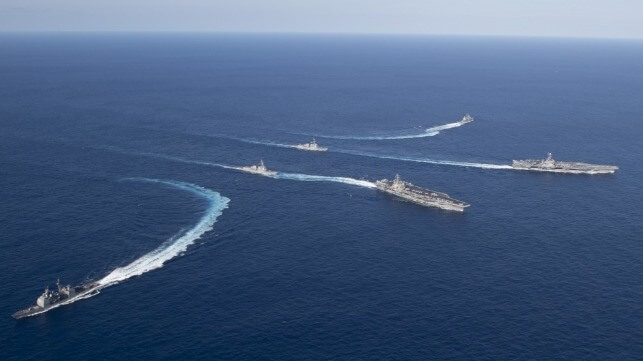U.S. 7th Fleet Calls for Increasing Carrier Presence in the Pacific

Far from backing away from the utility of the aircraft carrier, the head of U.S. 7th Fleet has called for expanding America's carrier presence in East Asia as a way to send the message that "today is not the day" for an unnamed nation's expansionist agenda.
Speaking at the conclusion of a 10-day, five-nation joint naval exercise in the Pacific, 7th Fleet commander Vice Adm. Karl Thomas suggested that the ability of America and its allies to muster a carrier force in the region is adequate - but could be even better. “When we think about how we might fight, it’s a large water space, and four aircraft carriers is a good number, but six, seven or eight would be better," he told the Wall Street Journal.
At present, one American carrier - USS Ronald Reagan - is forward-deployed at 7th Fleet's home base in Yokosuka, Japan. Reagan is often joined by one or more additional U.S. Navy carriers passing through the region, most recently USS Carl Vinson. America's allies - particularly Britain - can also contribute carrier power if needed, and Japan and South Korea are both considering escort-carrier options that would enable them to join in.
Vice Adm. Thomas' endorsement of carrier power comes as China invests in tough-to-intercept hypersonic antiship missiles, specifically designed to damage or destroy supercarriers. The PLA Rocket Force has even set up a desert test range with a two-dimensional target shaped exactly like a U.S. Navy Ford-class carrier, "escorted" by a mock Arleigh Burke-class destroyer several miles away.
The PLA's latest long-range weapons are designed to exit the atmosphere and return to earth at speeds exceeding Mach 5, maneuvering to avoid missile defense systems on final approach. The largest version is capable of reaching Guam from the Chinese mainland, providing coverage for all of the South China Sea and nearby waters. Some Western naval analysts have expressed concern that this anti-access / area denial capability will reduce the ability of American carriers to engage in the event of a conflict in the region.
According to Vice Adm. Jon Hill, director of the Missile Defense Agency, the Navy already has a front-line terminal defense against hypersonic weapons in the form of the Aegis antiballistic missile platform, deployed on Arleigh Burke-class destroyers. Earlier this year, Hill told the Senate Armed Services committee that for a long-term solution, the MDA wants to "move further back into that trajectory, engage earlier, make the terminal defense even better." A purpose-built interceptor for hypersonic weapons in the glide (mid-course) phase of flight is under accelerated development. In addition, new tracking satellites that can accurately follow hypersonic targets and guide in interceptor missiles are now under design and testing.
